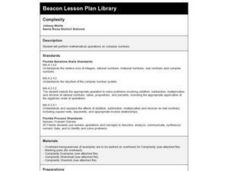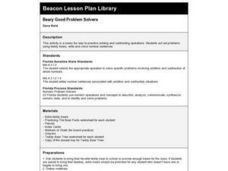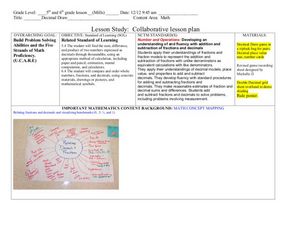Lorain County Community College
Fractions Part Three
See how well your mathematicians know their fractions with a challenging worksheet full of different problems. It's all there with adding, subtracting, multiplying, and division. They will be proficient with order of operations and...
Khan Academy
Challenge: Your First Button
Practice using conditional if statements, Boolean expressions, and Boolean operators by programming a user-selected button. This activity guides by using a small program that needs some modifications to work correctly.
Curated OER
Taxes and Sales
Collaborative discussions around this retail store problem will be taxing. Calculating discount and tax and the order of the operations are used to motivate an opportunity for learners to make a convincing argument using algebraic...
Curated OER
Using Random Sampling to Draw Inferences
Emerging statisticians develop the ability to make inferences from sample data while also working on proportional relationships in general. Here, young learners examine samples for bias, and then use random samples to make...
Houghton Mifflin Harcourt
Unit 2 Math Vocabulary Cards (Grade 4)
The 28-page resource contains cards with terms relating to multiplication from inverse operations to front-end estimation to array. Each sheet contains two cards; one with the word and one with the definition.
EngageNY
The Multiplication of Polynomials
If you can multiply multi-digit integers, you can multiply polynomials. Learners use an area model to compare multiplying numbers to multiplying polynomials. They progress to using the distributive property.
EngageNY
Writing and Evaluating Expressions—Multiplication and Addition
How many people can sit around a table? The 22nd part in a series of 36 continues the work on writing and evaluating expressions to include expressions with two operations. Pupils use models to determine an expression for the number of...
Kenan Fellows
Isotopic Pennies
Many people confuse atomic mass and atomic numbers. The sixth of seven lessons in a unit requires scholars to find the weight of different groups of pennies. Then, they must solve how many of each type of penny exists in a closed system...
Cold Spring Harbor Laboratory
DNA Words Are Three Letters Long
DNA writes 64 different words but only codes for 20 different amino acids. Budding scientists learn about where each of these numbers come from and why they aren't equal with an online interactive. The resource explains the research, the...
Curated OER
Secret Sequences
Learners are exposed to different types of sequences. in this sequencing lesson, students learn about simple sequences, multiplication sequences, declining sequences, the Fibonacci sequence and other sequences.
Curated OER
Complexity
Students perform mathematical operations on complex numbers. After a lecture/demo, students utilize a worksheet imbedded in this plan to gain practice performing operations on complex numbers.
Curated OER
A Beginning Look at Basic Algebra-Lesson 1-12
In this Algebra I worksheet, 9th graders explore the basic of beginning algebra: the order of operations, integer operations, translating phrases and sentences, and solving basic one-step equations. The six page worksheet...
Curated OER
Place Value: Calculator Work
In this place value worksheet, students solve 15 various math operation questions. The first 5 questions ask students to figure out the operation, using a calculator, that changes one number to another. The next 5 questions ask students...
Curated OER
Beary Good Problem Solvers
First graders role-play addition and subtraction operations with teddy bears. They practice with the bears first, then write and solve the problems.
Curated OER
Pigs and Ducks
Second graders use multiplication to solve problems. They use the multiplication facts for 2 and 4. Students combine operations to solve the problem and they devise and apply problem solving strategies.
Curated OER
Cups and Cubes
Third graders explore the use of cups and counters as a model to analyze the effects of operations. They create and use a rule to create a sequential pattern and use cups and cubes to model the relationship.
Curated OER
Four 4's
Students use the numbers 24 and 44 as well as four more fours to create a series of equations. Each equation should equal a number from 1-20. They work to find an equation for each number.
Curated OER
50 State Quarter Game
Students, using their knowledge of place value and number sense, play this counting game in small groups, or as a whole class, to see who be the first person to reach 50 cents.
Curated OER
Factors, Divisibility, and Relatively Prime
Seventh graders explore the concept of divisibility. In this divisibility lesson, 7th graders use divisibility rules to find factors of numbers. Students create foldables to illustrate divisibility rules.
Curated OER
Who Has More?
Students engage in a activity that is concerned with the standard of comparing the quantities of whole numbers using different strategies from the concrete to the abstract. They count objects and compare them, use symbols of comparison,...
Curated OER
Decimals: Collaborative Lesson
Students explore mathematics by participating in a group activity. In this number value lesson, students identify the uses for decimals and how to best estimate whole numbers based on decimals and fractions. Students collaborate with...
Curated OER
At The Movies
Students work systematically to find all the possible combinations. They Students write and solve problems which involve whole numbers and which require a choice of one or more of the four arithmetic operations.
Curated OER
Exploring Integers
Students implement rules for adding, subtracting, dividing, and multiplying negative integers. They write rules for each mathematical operation of negative numbers. In groups, students complete number operations. Using PDAs, they share...
Helping with Math
Division: 3-digit by 1-digit
Twenty-four problems fit neatly on this division worksheet. For each, youngsters must divide a three-digit number by a single digit. There will be remainders in all of the problems, so make sure not to assign it until you have thoroughly...
Other popular searches
- Whole Number Operations
- Operations With Whole Numbers
- Math Numbers and Operations
- Missing Numbers or Operations
- Operations With Mixed Numbers
- Operations With Real Numbers
- Operations and Numbers
- Numbers and Operations Grade 1

























